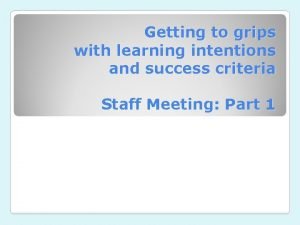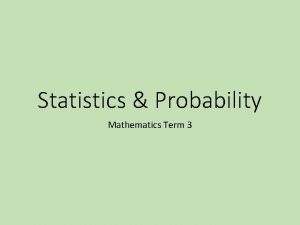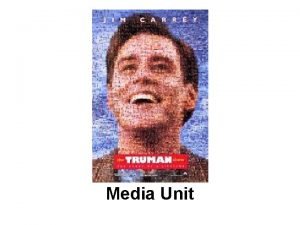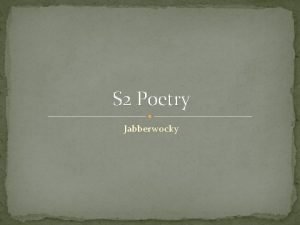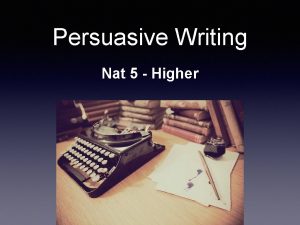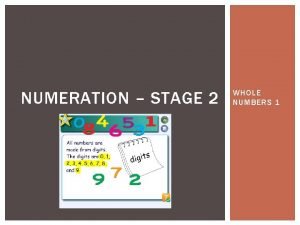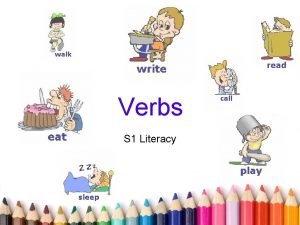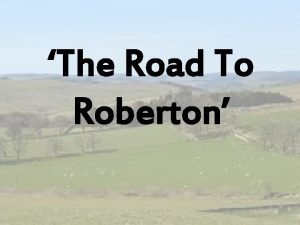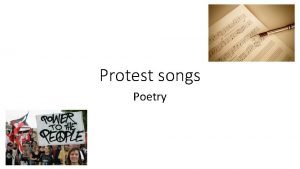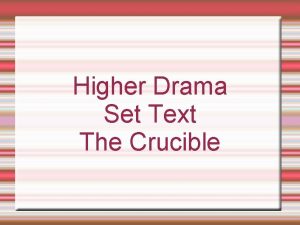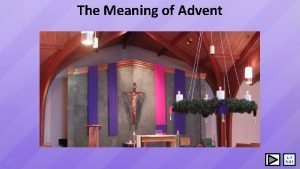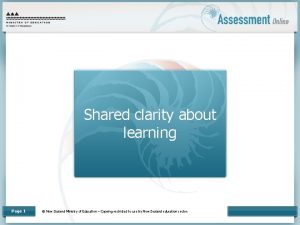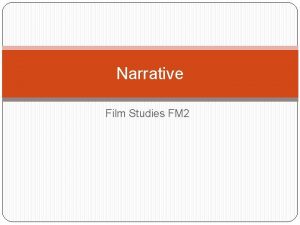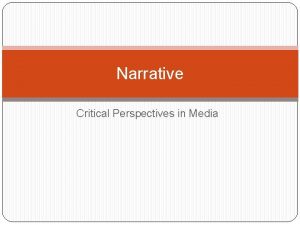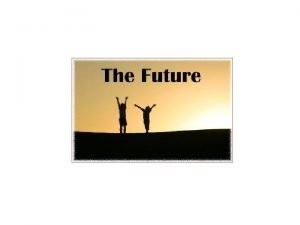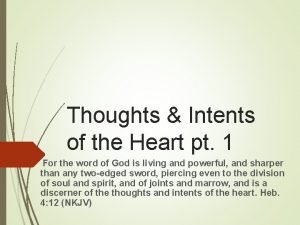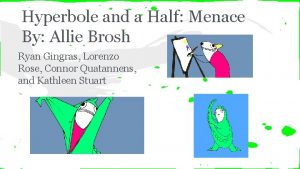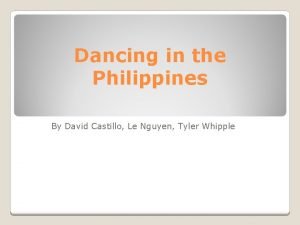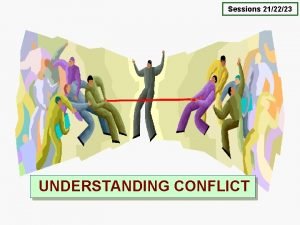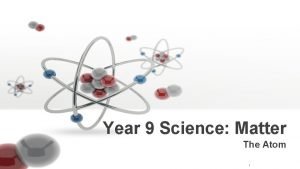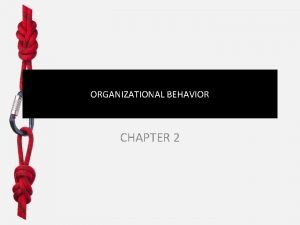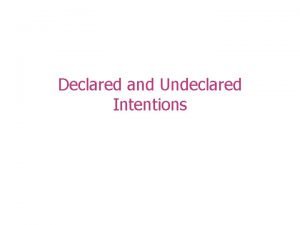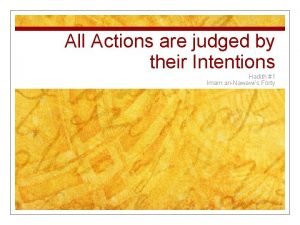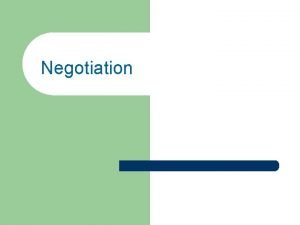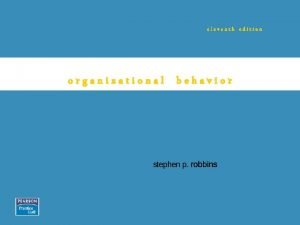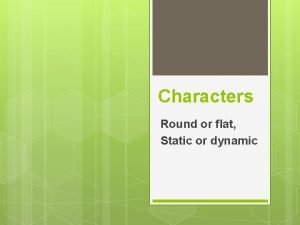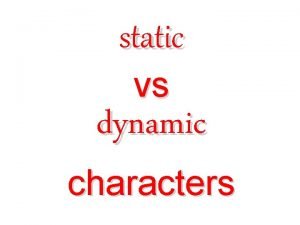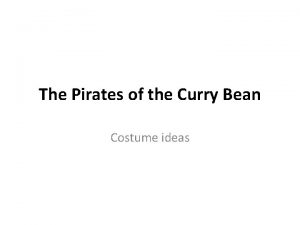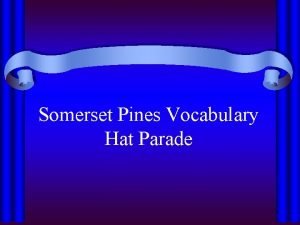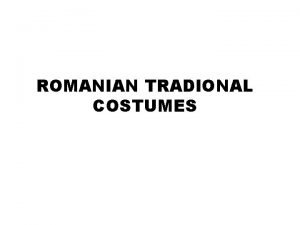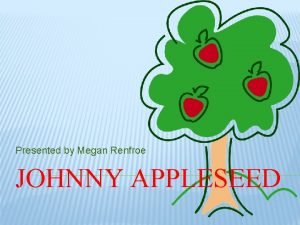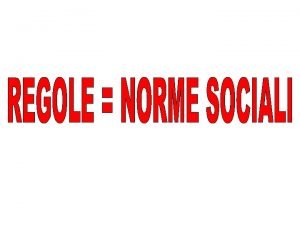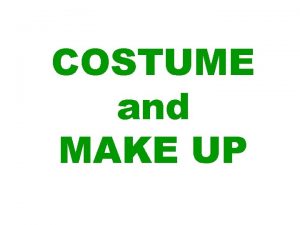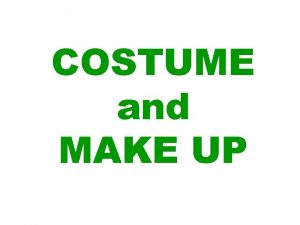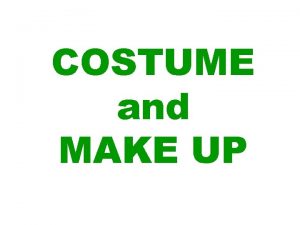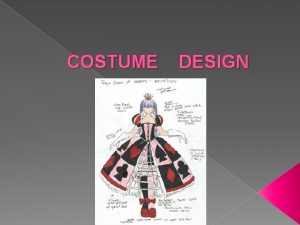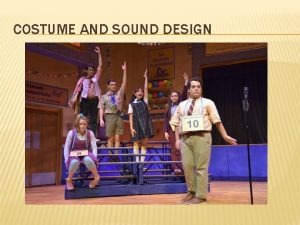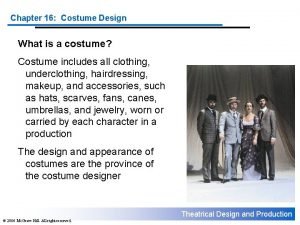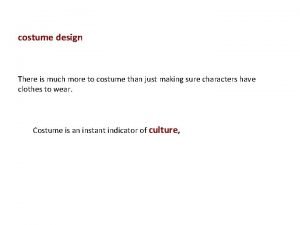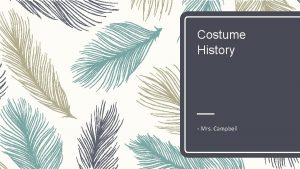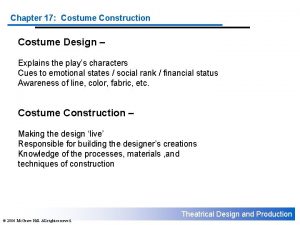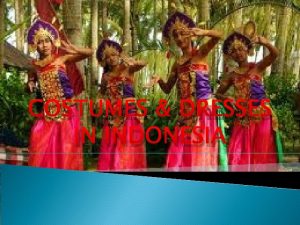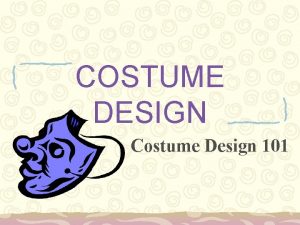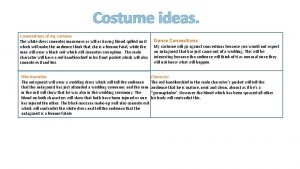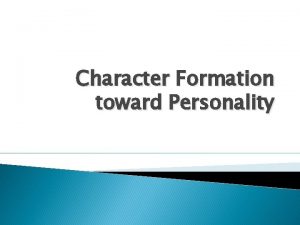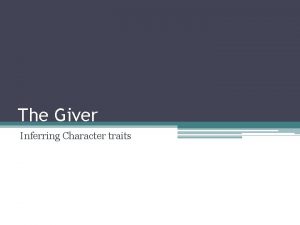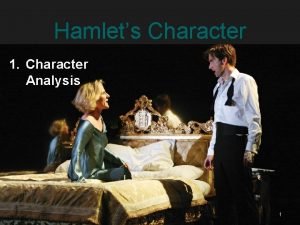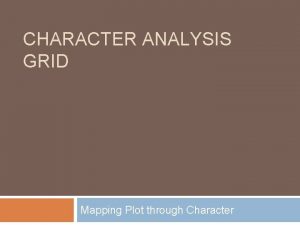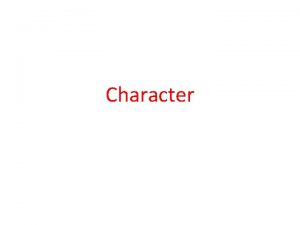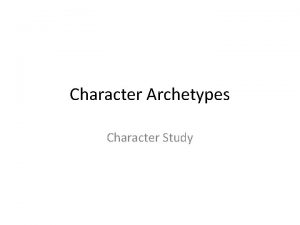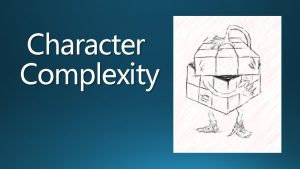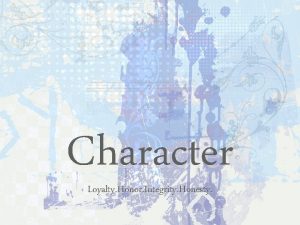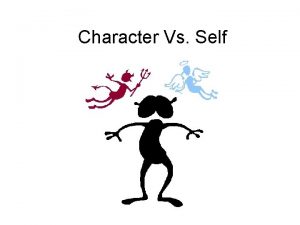Media Unit Costume and Character Learning Intentions To















































- Slides: 47

Media Unit

Costume and Character Learning Intentions: * To understand why costumes are important in movies. * To consider what the main characters’ costumes tell us about their characters.

This character is clearly good as he is wearing white (the colour of purity). He also seems to be wise due to his white hair and beard which makes him look older, as well as the thoughtful expression on his face. He appears to be wearing robes which could make him a religious or important figure. This character also seems to be important due to his robes, but because he is in black we assume he is evil. He also looks stern and grim.

What do these costumes suggest about the characters? 1 2

Task 2 What do the costumes of Truman, Christof and Meryl tell us about their characters?

Task 2 Truman • Casual suit with briefcase – smart, old fashioned, professional • Colourful – yellow – suggests happiness/sunshine • Short hair – organised, order, his life is controlled and never chaotic • Pale colours – relaxed, calm, positive/innocent Meryl • Nurse’s uniform – important job, feminine, helpful • White – clean, professional • Hair tied back – organised, not relaxed, at work Christof • Dark colours – evil • Hat – pretentious, artictic/creator • Simple clothes – not interested in what people think about him, no time to keep up with fashion

Task 3 Draw two tables in your jotters like the one below. Make sure you take a brand new A 4 page for each character’s table and do one for Truman and one for Meryl and Christof. Fill in the tables with things we have learned about the characters so far. If you can, try to come up with more than just basic facts. HINT: Think about their personalities and how they feel about what they do. What have we learned about the character? Evidence from the film

Camera Work Learning Intentions: * To understand why particular camera shots and angles are used. *To be able to comment on the effect of these in the film.

Type of camera shot or angle? Why has it been used?

Type of camera shot or angle? Why has it been used?

Type of camera shot or angle? Why has it been used?

Type of camera shot or angle? Why has it been used?

Type of camera shot or angle? Why has it been used?

Task 2 (practice) • You will be watching a short scene from the film and must take notes on which shots are used. • Try also to explain why these shots have been used, whether it be to teach us something about the characters or to have a particular effect on the audience. • Don’t worry if you can only get a few as this is just for practice!

Task 2 • You will now be doing exactly the same with another scene. Put the following table in your jotters and fill it in while watching. • You will be watching the clip 3 times so don’t rush. Type of shot What is it of? Why has it been used? Effect?

Task 3 - Camera Movement This task involves knowing about different types of camera movement. On the following slides, you will find examples of different camera movements from films. The definition of each kind is also in your booklets.

Crane shot • The camera is mounted on to a crane which can then swing up high and look in all directions. • Here is an example from “The Player” (Robert Altman, 1989): • http: //www. youtube. com/watch? v=0 ep. B 5 Z 6 ijpk • Purpose/Effect?

Tracking • The camera moves with the subject wherever it goes. • Here is an example from “Intentions of Murder” (Shohei Imamura, 1964): • http: //www. youtube. com/watch? v=q. Cobnf. T 3 Vd o • Purpose/Effect?

Panning • The camera base is in a fixed position but the camera moves around the scene. • Here is a short example: • http: //www. youtube. com/watch? v=H 4 RJJDd. Yyo • Purpose/Effect?

Handheld • Camera is held by the camera operator so movement is jerky. • Example from: “Saving Private Ryan” (Steven Spielberg, 1998) • http: //www. youtube. com/watch? v=Ece. Sc-8 h 8 gk • Purpose/Effect?

Dolly zoom shot • Camera zoom is used to keep character same size while camera physically moves in on a dolly. • Example from: “Jaws” (Steven Spielberg, 1974) • http: //www. youtube. com/watch? v=NB 4 bikr. Nz Mk • Purpose/Effect?

Task 3 • Re-watch the opening scene. • In pairs, you must try to pick out at least 4 types of camera movement used. Also try to comment on why they worked well in this particular scene.

Mise-en-scene Learning Intentions: * To understand what is meant by the term mise-en-scene. To be able to comment on the effectiveness of particular scenes and stills from The Truman Show.

Mise-en-scene French, meaning “put in the scene”. It involves everything you see in the frame: –Costume –Set –Props –Lighting –Actor position You need to understand that everything in the frame was carefully placed there for a reason.

Setting? What are the characters doing? Christof’s costume? Christof’s positioning? Positioning of minor characters? lighting?

Setting – They are in one dark room with a glass window behind them, this is suspended in the sky above Truman’s world and is the control centre Christof’s costume – Dark colours suggest that he is a dark, evil, untrustworthy character, his clothes stand out from the other outfits showing that he is not one of them What are the characters doing – they are staring at a screen and mostly focused on one action, Christof appears surprised and the man next to him is making notes and awaiting instructions from Christof that he does not want to miss Christof’s positioning – He is in the centre at the front of the shot showing that this whole scene revolves around him, that he is controlling the actions and believes himself to be a god. Positioning of minor characters – the minor characters are further away from the camera and turned away at the side, showing they are less important Lighting – In this room it is dark which suggests they are engaging in harmful actions, behind them in Truman’s world it is light with blue skies showing the purity and innocence that these characters are not part of.

Task 1 Comment on the effectiveness of the mise-en-scene in the following stills. Try to comment on as many factors as you can: Costume Lighting Object/character placement Props Set

No. 1

No. 2

No. 3

No. 4

Lesson 8 - Sound Learning Intentions: * To understand how sound is used to subtly influence an audience. * To consider the effective use of sound in a scene from The Truman Show.

Discuss (10 mins) 1. Why is sound/music important in movies? 2. What different purposes could it be used for? Think about different genres. 3. Can you think of any example sounds which are used for a particular purpose? (e. g. thumping heartbeat to create suspense and lead up to something) 4. Can you think of any movies that wouldn’t be the same without the sound effects, soundtrack or score?

Different types of sound • Sound effects – Noises added to film for reality or effect. • Soundtrack – Songs added onto film to reflect character’s thoughts/feelings or to create mood/atmosphere. • Score – Instrumental music (mostly), written specifically for film for mood/atmosphere.

Two types of sound – Diegetic: sound whose source is visible on screen. - characters’ voices sounds made by objects in the story music coming from instruments on screen – Non-diegetic: sound whose source seems to be off screen. - narrator’s commentary sound effects which are added for dramatic effect mood music/the score

Task 1 Put the following table in your jotters and fill it in as you watch. What sound? Diegetic Nondiegetic X X Why was it used? Effect?

Task 2 Put the following table in your jotters and fill it in as you watch. What sound? Diegetic Nondiegetic X X Why was it used? Effect?

Lesson 9 - Music Learning Intentions: * To understand why particular scores are used in films. * To consider the different effects music can have on an audience.

Different types of sound • Sound effects – Noises added to film for reality or effect. • Soundtrack – Songs added onto film to reflect character’s thoughts/feelings or to create mood/atmosphere. • Score – Instrumental music (mostly), written specifically for film for mood/atmosphere.

Music Background music (or the score) is composed carefully for a film. The composer and musicians will play the music along with the finished film so that it fits each scene perfectly. You are going to listen to 5 clips of music from different film soundtracks. You will have to: 1) Guess what film the score is from. 2) Briefly describe each clip (there is a wordbank to help you). 3) Decide what film genre each clip belongs to. 4) Say why you think that clip matches the chosen genre.

Musical Score Test Number 1 https: //www. youtube. com/watch? v=AI 0 Hv. QN 9 Sl 0 Number 2 https: //www. youtube. com/watch? v=Zv. CI-g. NK_y 4 Number 3 https: //www. youtube. com/watch? v=m 9 We 2 Xs. VZ fc Number 4 https: //www. youtube. com/watch? v=e 8 TZbze 72 B c Number 5 https: //www. youtube. com/watch? v=z. Hal. Xjs 0 c. DA Word Bank menacing victorious joyful heartbreaking scary strange calm lively dramatic sad fast slow happy powerful dark light hopeful inspirational

Musical Score Test 1. Harry Potter 2. Jaws 3. Ghostbusters 4. Back to the Future 5. Jurassic Park Word Bank menacing victorious joyful heartbreaking scary strange calm lively dramatic sad fast slow happy powerful dark light hopeful inspirational

Task 2 You will be re-watching the beginning and the ending of the film and commenting on the effectiveness of the music used. Think about and make notes on the following: 1. Why does the music work well with what’s happening on screen? 2. Have you heard this music before in the film? Is it used for any particular scenes? 3. Are there any changes in the music or its tempo? Why do you think this is? 4. Camera angles and other techniques and why they are used

Lesson 11 - Theme Learning Intentions: * To understand what themes of The Truman Show are. * To be able to pick out parts of the film where this theme was explored.

Discuss • What are themes of The Truman Show? • What topics are explored through the plot? • What are we meant to learn a lesson about?

Task 1 You are going to be tracing themes through the film. Using theme timelines, pick out different parts of the film that explored one of the following themes: Fear Escape Discovery/realisation Trust Control Betrayal Family Reality Technology American Dream

Theme ideas • Family: what is Truman’s relationship like with his mother, father, Christof and Meryl? How do the relationships change? • Control/Reality: How is control/reality shown? How does it affect Truman’s life? How do Truman and Christof feel about this? How does it affect the plot? • Realisation/Escape: How does Truman’s increasing understanding impact his life? Why does he want to escape? How does this affect the plot/characters? • Technology: How is it shown/important? How does it impact on Truman’s life and the plot? • American Dream: How does this link to Truman’s life? How is shown to be great or a failure? • Trust/Betrayal: Who is trustworthy? Who trusts or does not trust who and why? How does this change? How is it important?
 Example learning intentions
Example learning intentions Learning intentions and success criteria examples
Learning intentions and success criteria examples Learning intentions and success criteria for mathematics
Learning intentions and success criteria for mathematics How to write learning intentions
How to write learning intentions Character intentions
Character intentions Jabberwocky alliteration
Jabberwocky alliteration Nat 5 persuasive essay
Nat 5 persuasive essay Place value learning intentions
Place value learning intentions Basking shark poem
Basking shark poem Objectives of fractions
Objectives of fractions Half-turn symmetry
Half-turn symmetry Learning intention verbs
Learning intention verbs Poetry learning intentions
Poetry learning intentions Poetry learning intentions
Poetry learning intentions Gap year poem
Gap year poem Reflective phrases
Reflective phrases Acrostic for r
Acrostic for r Drama learning intentions
Drama learning intentions The meaning of advent worksheet
The meaning of advent worksheet Absolum duffy
Absolum duffy Narrative learning intentions
Narrative learning intentions Binary opposition examples
Binary opposition examples What is assessment
What is assessment Going to is used for plans, decisions and intentions.
Going to is used for plans, decisions and intentions. Hebrews 4 12 amplified version
Hebrews 4 12 amplified version Cuadro comparativo e-learning y b-learning
Cuadro comparativo e-learning y b-learning Allie brosh dinosaur
Allie brosh dinosaur Poem about tinikling
Poem about tinikling Creative intention meaning drama
Creative intention meaning drama Process of conflict
Process of conflict Good intentions
Good intentions Intentions atom
Intentions atom Personal attitudes affect behavior via intentions.
Personal attitudes affect behavior via intentions. Undeclared intentions
Undeclared intentions Actions are judged by intentions hadith
Actions are judged by intentions hadith Mythical fixed pie
Mythical fixed pie Negotiation in organizational behavior
Negotiation in organizational behavior Unit 6 review questions
Unit 6 review questions Round character
Round character What are static characters
What are static characters Pas or pin
Pas or pin Hungary national costume
Hungary national costume Pirates of the curry bean
Pirates of the curry bean What did kat get from glimmer's body
What did kat get from glimmer's body Vocabulary hat
Vocabulary hat Red flexer timisoara
Red flexer timisoara Johnny appleseed costume
Johnny appleseed costume Esempi di norme religiose
Esempi di norme religiose
